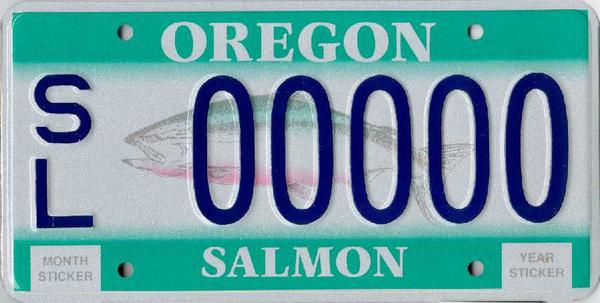Salmonid fishes can be found in subarctic waters worldwide. However, for more than a century, “salmon” have been virtually synonymous with the Pacific Northwest. In fact, the Chinook Salmon is the official State Fish of Oregon–drivers may even choose to display this magnificent creature on their bumpers:

An historical essay published in the Daily Morning Astorian on January 29, 1887 suggests that the salmon might have played a small but important role in Oregon’s ever becoming an America territory. Entitled ‘The Boundary Question. How the Oregon Trouble was Settled and the Country was Saved From War,’ this article relates that a man named Gordon, commander of the English man-of-war America, concurred with John McLaughlin’s assessment that the Columbia River country was ‘not worth a war’ with the United States. Remarkably, the article reports that the commander’s dismissive opinion was based upon his observation, “…being fond of angling, the salmon would not rise to the fly. A country where the fish were not lively enough for his sport was, in his estimation, worthless.”

Whatever the quality of sport on offer, at the time of the first Euro-American settlement, the salmon fisheries of the Pacific Northwest seemed literally inexhaustible. Millions of fish averaging thirty pounds and more made the annual spawning run up Oregon’s numerous coastal rivers. They were an important food resource for both indigenous peoples and the pioneer settlers. In fact, the fish were so abundant that people often kept only the choicest cuts of meat and threw the rest away! The first commercial harvest of salmon by Euro-American settlers in Oregon occurred in 1823. Many thousands were caught every year thereafter, but for a while it seemed as if all the people in Oregon would never be able to eat enough salmon to put even a small dent in the overall population of fish.

But then, by the 1860s, new inventions and improvements in food canning technology suddenly made it possible for Oregon businesses to preserve the catch and transport it for sale to markets around the globe. It was at this time that canned ‘Pacific Salmon’ became a popular staple of the American diet, available on grocery shelves almost everywhere.

(Image from Oregon Blue Book’s ‘Historical Oregon Trademarks Web Exhibit’)
The Oregon newspaper titles presently available on Chronicling America provide us with a wealth of information about salmon and commercial salmon fishing. Here we can read about the rapid development of the state’s salmon canning industry and its major contributions to the early economic growth of the state–but also the subsequent emergence of a public conservation ethos as Oregonians began to notice, within a decade or two, some of the grimmer consequences of that industry’s success.

As a point of entry, try the front page of the Daily Morning Astorian from January 27, 1888, where we find an article headlined ‘STATEMENTS AND SUGGESTIONS. Report of the State Fish Commission.’ This story details initial efforts to regulate the Columbia River salmon fishery, and also discusses other factors then known to pressure salmon populations, such as the widespread disposal of sawdust in rivers, and predation by sea lions.
On April 6, 1904, the Sumpter Miner ran a story, ‘Oregon Owns World’s Big Fish Hatchery.’ The largest hatchery in the world had recently begun operating on the Snake River near Ontario, Oregon. The Miner reports that the hatchery will soon be releasing its first batch of fry: more than 25,000,000 young salmon to be stocked into the Columbia watershed in hopes of maintaining the fishery in the long term.
Page 7 of the April 9, 1911 Medford Mail Tribune offers a piece entitled ‘Uncle Sam Studies Traits of Salmon.’ This is an excellent account of the actual scientific methodology used by the federal Bureau of Fisheries to begin tracking the natural life cycle of Pacific salmon species. Here we find the beginnings of ‘fish tagging.’ Prior to this time in the early 20th century, there was much that had remained mysterious about the annual comings and goings of salmon in Oregon’s ocean and rivers.

(Image from Native American Legal Update)
Interested in learning more? There are many resources online! For example, Oregon State University Libraries offers an informative overview of the seven salmon species native to our state. And on their website, Oregon Public Broadcasting provides a detailed timeline of the History of Fishing in Oregon. —Jason A. Stone
